The Effect of Particle Size on Sediment Accumulation in Permeable Pavements
Abstract
:1. Introduction
2. Materials and Methods
2.1. Experimental Configurations
2.2. Aggregate Types
2.3. Sediment Application
2.4. Sediment Analysis
3. Results
4. Discussion
5. Conclusions
Acknowledgments
Author Contributions
Conflicts of Interest
References
- Sansalone, J.; Kuang, X.; Ying, G.; Ranieri, V. Filtration and clogging of permeable pavement loaded by urban drainage. Water Res. 2012, 46, 6763–6774. [Google Scholar] [CrossRef] [PubMed]
- Myers, B.R.; Beecham, S.; Van Leeuwen, J.; Keegan, A. Depletion of E. coli in permeable pavement mineral aggregate storage and reuse systems. Water Sci. Technol. 2009, 60, 3091–3099. [Google Scholar] [CrossRef] [PubMed]
- Chowdhury, R.K.; Sharvelle, S.E.; Beecham, S. Greywater quality changes in a permeable pavement reservoir. Proc. Inst. Civ. Eng. Water Manag. 2016, 169, 190–198. [Google Scholar] [CrossRef]
- Beecham, S.; Myers, B. Structural and design aspects of porous and permeable block pavements. J. Aust. Ceram. Soc. 2007, 43, 74–81. [Google Scholar]
- Brattebo, B.O.; Booth, D.B. Long-term stormwater quantity and quality performance of permeable pavement systems. Water Res. 2003, 37, 4369–4376. [Google Scholar] [CrossRef]
- Myers, B.; Beecham, S.; van Leeuwen, J. Water quality with storage in permeable pavement basecourse. Proc. Inst. Civ. Eng. Water Manag. 2011, 164, 361–372. [Google Scholar] [CrossRef]
- Aryal, R.; Beecham, S.; Lee, B. Evaluation of particle transport in permeable pavements under oil loadings. KSCE J. Civ. Eng. 2015, 19, 2000–2004. [Google Scholar] [CrossRef]
- Kazemi, F.; Hill, K. Effect of permeable pavement basecourse aggregates on stormwater quality for irrigation reuse. Ecol. Eng. 2015, 77, 189–195. [Google Scholar] [CrossRef]
- Lucke, T.; Beecham, S. Field investigation of clogging in a permeable pavement system. J. Build. Res. Inf. 2011, 39, 603–615. [Google Scholar] [CrossRef]
- Boogaard, F.; Lucke, T.; van de Giesen, N.; van de Ven, F. Evaluating the infiltration performance of eight Dutch permeable pavements using a new full-scale infiltration testing method. Water 2014, 6, 2070–2083. [Google Scholar] [CrossRef]
- Boogaard, F.; Lucke, T.; Beecham, S. Effect of age of permeable pavements on their infiltration function. Clean Soil Air Water 2013, 42, 146–152. [Google Scholar] [CrossRef]
- Pezzaniti, D.; Beecham, S.; Kandasamy, J. Influence of clogging on the effective life of permeable pavements. Proc. Inst. Civ. Eng. Water Manag. 2009, 162, 76–87. [Google Scholar] [CrossRef]
- Fassman, E.; Blackbourn, S. Urban runoff mitigation by a permeable pavement system over impermeable soils. J. Hydrol. Eng. 2010, 15, 475–485. [Google Scholar] [CrossRef]
- Bean, E.Z.; Hunt, W.F.; Bidelspach, D.A. Evaluation of four permeable pavement sites in eastern North Carolina for runoff reduction and water quality impacts. J. Irrig. Drain. Eng. 2007, 133, 583–592. [Google Scholar] [CrossRef]
- Nichols, P.W.B.; Lucke, T.; Dierkes, C. Comparing two methods of determining infiltration rates of permeable interlocking concrete pavers. Water 2014, 6, 2353–2366. [Google Scholar] [CrossRef]
- Nichols, P.W.B.; White, R.; Lucke, T. Do sediment type and test durations affect results of laboratory-based, accelerated testing studies of permeable pavement clogging? Sci. Total Environ. 2015, 511, 786–791. [Google Scholar] [CrossRef] [PubMed]
- Kumar, K.; Kozak, J.; Hundal, L.; Cox, A.; Zhang, H.; Granato, T. In-situ infiltration performance of different permeable pavements in an employee used parking lot—A four-year study. J. Environ. Manag. 2016, 167, 8–14. [Google Scholar] [CrossRef] [PubMed]
- Støvring, J.; Dam, T.; Jensen, M.B. Surface sedimentation at permeable pavement systems: Implications for planning and design. Urban Water J. 2018, 15, 124–131. [Google Scholar] [CrossRef]
- Kazemi, H.; Rockaway, T.D.; Rivard, J.; Abdollahian, S. Assessment of surface infiltration performance and maintenance of two permeable pavement systems in Louisville, Kentucky. J. Sustain. Water Built Environ. 2017, 3, 1–17. [Google Scholar] [CrossRef]
- Concrete Masonry Association of Australia (CMAA). Permeable Paving Design Guidelines. Available online: https://cmaa.blob.core.windows.net/media/1044/pe01-permeable-interlocking-concrete-pavements-design-and-construction-guide.pdf (accessed on 10 May 2017).
- Oades, J.M.; Waters, A.G. Aggregate hierarchy in soils. Aust. J. Soil Res. 1991, 29, 815–828. [Google Scholar] [CrossRef]
- Van Duin, B.; Brown, C.; Chu, A.; Marsalek, J.; Valeo, C. Characterization of long-term solids removal and clogging processes in two types of permeable pavement under cold climate conditions. In Proceedings of the 11th International Conference on Urban Drainage, Edinburgh, UK, 31 August–5 September 2008. [Google Scholar]
- Yong, C.F.; Deletic, A.; Fletcher, T.D.; Grace, M.R. Hydraulic and treatment performance of pervious pavements under variable drying and wetting regimes. Water Sci. Technol. 2011, 64, 1692–1699. [Google Scholar] [CrossRef] [PubMed]
- Tadiar, K. An Examination into the Mechanisms and Behaviours Associated with Sediment Accumulation in Permeable Pavements. Ph.D. Thesis, University of South Australia, Adelaide, Australia, 2017; p. 225. [Google Scholar]
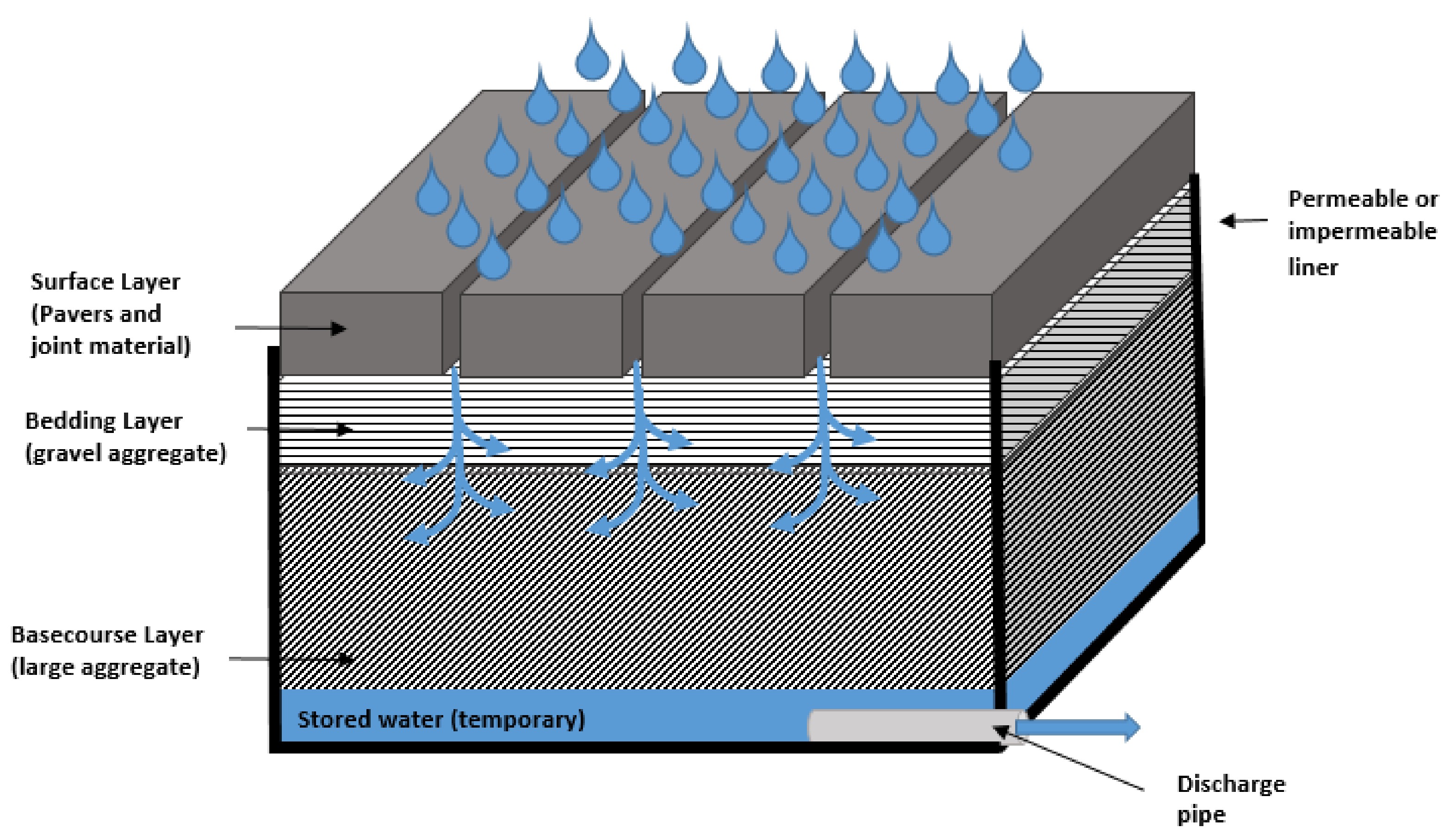



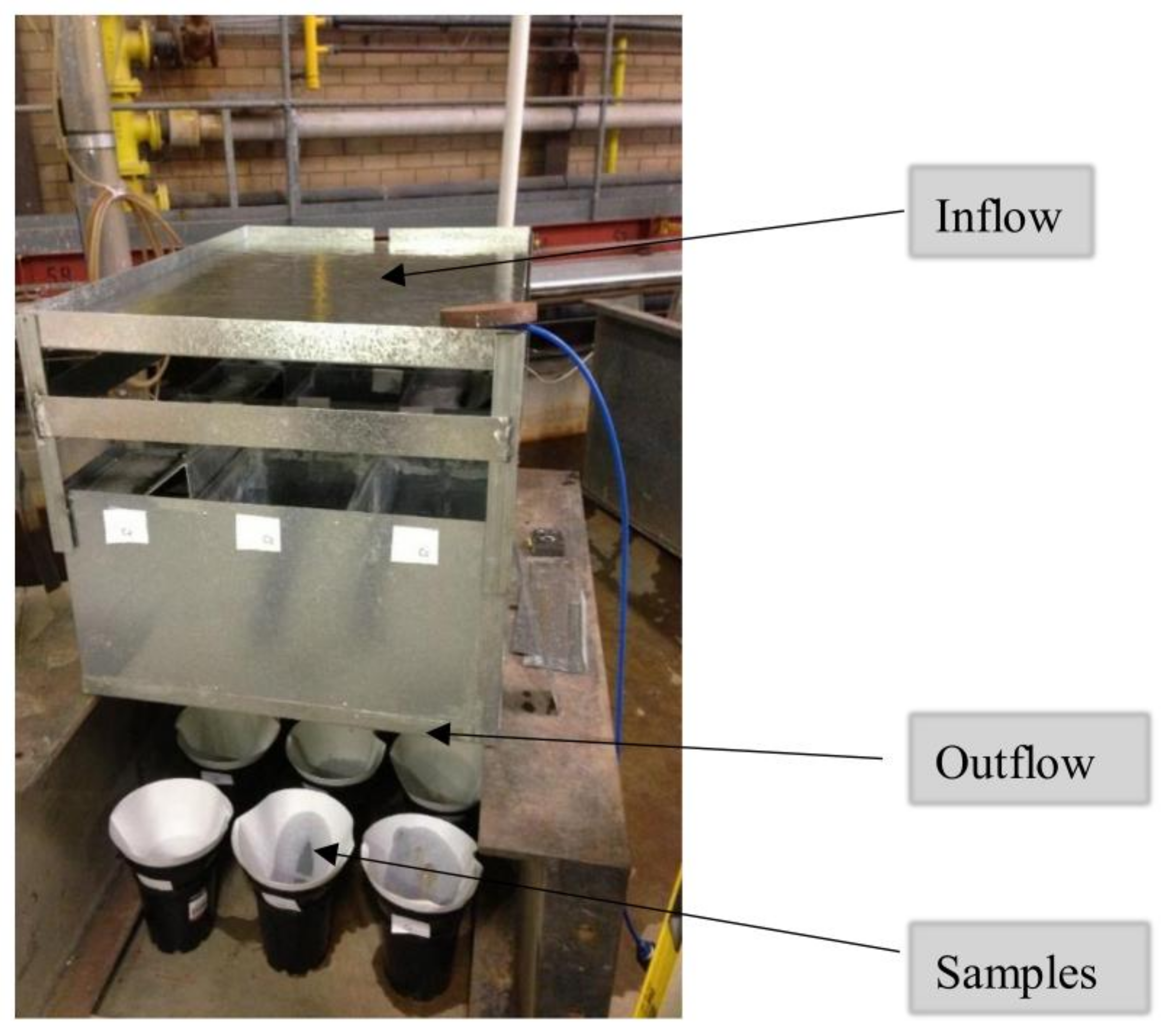
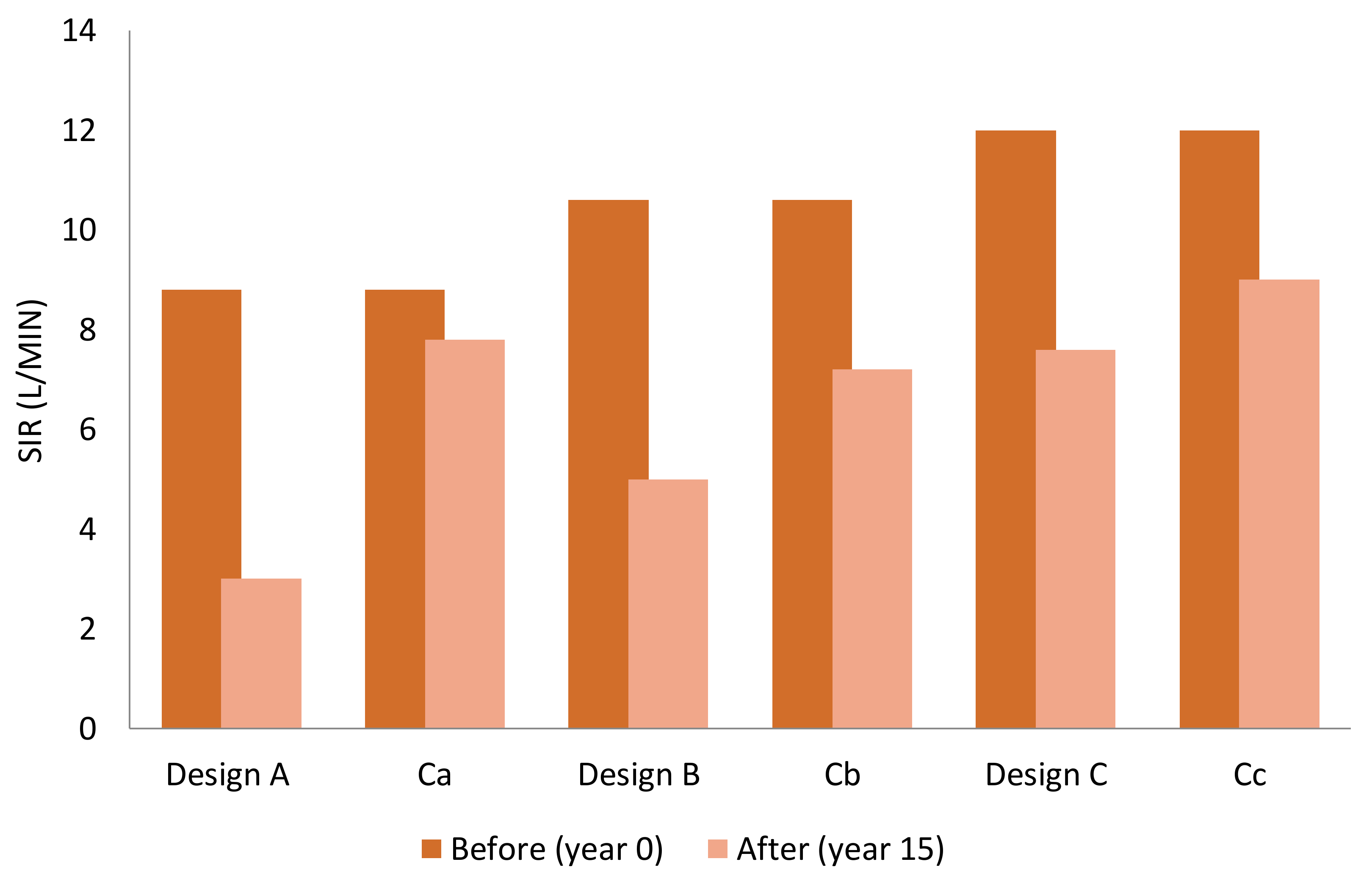
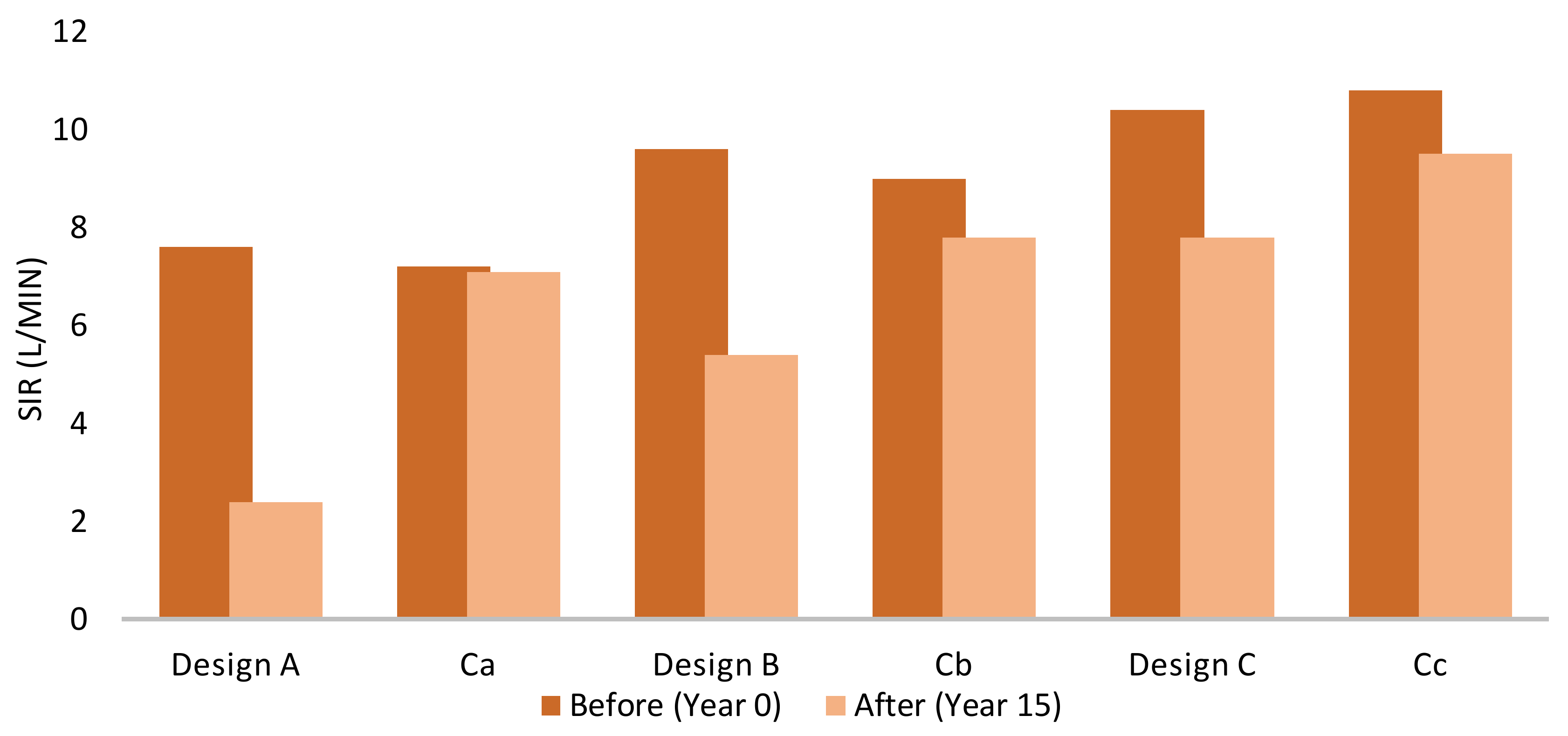
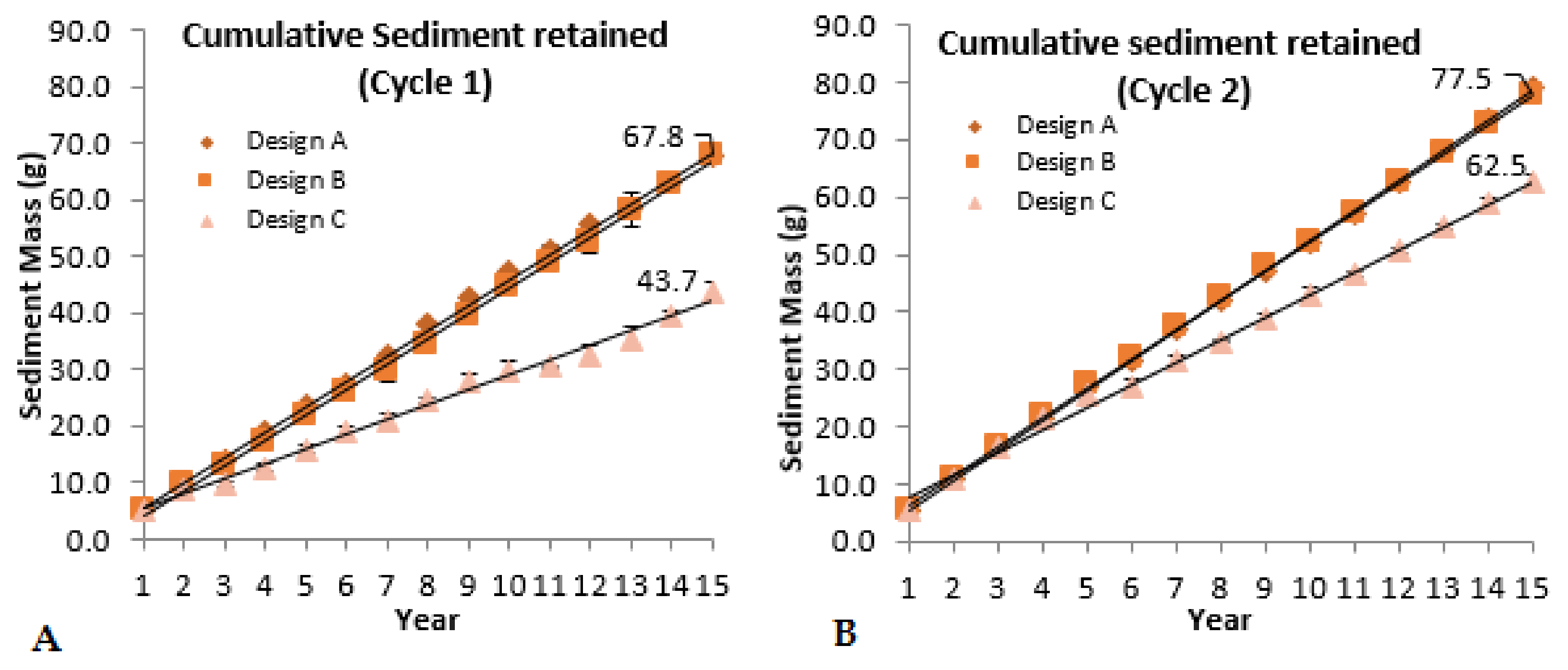
| Mono-Sized Sediment Number | Average Sediment Size of Mono-Sized Sediment ‘Mode’ (µm) | Fraction (µm) | PSD D50 (µm) | PSD D90 (µm) | Percentage per Sediment Load (%) | Volume over 15 Years (g) |
|---|---|---|---|---|---|---|
| 1 | 13.2 | <20 | 8.4 | 21.4 | 49 | 36.45 |
| 2 | 22.9 | 20–38 | 14.4 | 34.2 | 15 | 12.15 |
| 3 | 26.3 | 40–50 | 12.7 | 39.0 | 15 | 12.15 |
| 4 | 79.4 | 75–90 | 29.5 | 109.2 | 6 | 6.15 |
| 5 | 120.2 | 106–125 | 131.8 | 183.1 | 6 | 6.15 |
| 6 | 208.9 | 200–212 | 212.4 | 318.5 | 6 | 6.15 |
| 7 | 316.2 | 300–315 | 343.9 | 484.8 | 1 | 2.1 |
| 8 | 478.6 | 400–425 | 516.2 | 759.7 | 1 | 2.1 |
| 9 | 549.5 | 500–560 | 724.4 | 1221.0 | 1 | 2.1 |
© 2018 by the authors. Licensee MDPI, Basel, Switzerland. This article is an open access article distributed under the terms and conditions of the Creative Commons Attribution (CC BY) license (http://creativecommons.org/licenses/by/4.0/).
Share and Cite
Hill, K.D.; Beecham, S. The Effect of Particle Size on Sediment Accumulation in Permeable Pavements. Water 2018, 10, 403. https://doi.org/10.3390/w10040403
Hill KD, Beecham S. The Effect of Particle Size on Sediment Accumulation in Permeable Pavements. Water. 2018; 10(4):403. https://doi.org/10.3390/w10040403
Chicago/Turabian StyleHill, Kelly Diane, and Simon Beecham. 2018. "The Effect of Particle Size on Sediment Accumulation in Permeable Pavements" Water 10, no. 4: 403. https://doi.org/10.3390/w10040403





